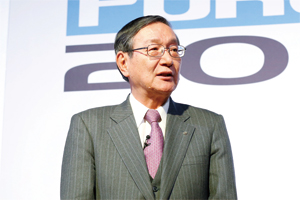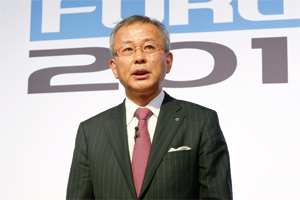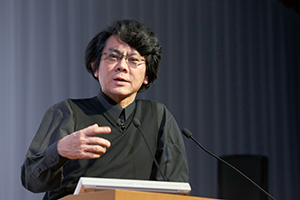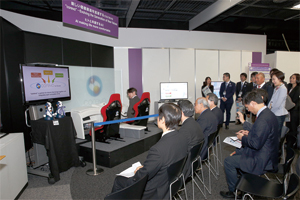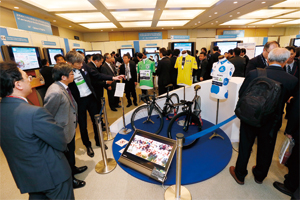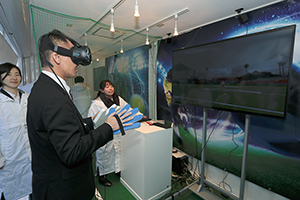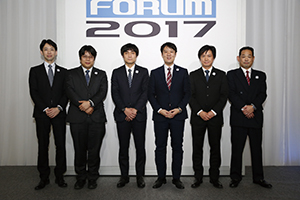 |
|
|
|
|
|
Information Vol. 15, No. 5, pp. 48–53, May 2017. https://doi.org/10.53829/ntr201705in1 Event Report: NTT R&D Forum 2017AbstractNTT held NTT R&D Forum 2017, an annual event, at NTT Musashino Research and Development Center from February 13 to 17, 2017 (with February 13 and 14 reserved for press tours and NTT Group company employees) under the theme “Open the Way—Towards 2020 and Beyond.” This article reports on this five-day event. Keywords: R&D Forum, information transmission, innovation 1. Overview of the forumThe NTT Group is making an all-out effort to become a value partner that will continue to be preferentially selected by customers. At NTT R&D Forum 2017, lectures and exhibits were presented on the latest research and development (R&D) results that support this effort. Specifically, the forum introduced in an easy-to-understand manner technologies related to artificial intelligence (AI), the Internet of Things (IoT), security, cloud computing, and networks, as well as other technologies that will shape the world in 2020. The forum was attended by both domestic and overseas customers of the NTT Group, staff members of partner companies, IR (investor relation) stakeholders, and people from government agencies and universities. 2. Lectures and workshopsIn his keynote address entitled “Generating New Value with xICT—Advancing B2B2X Business—” on February 15, Hiroo Unoura, NTT President and CEO, talked about advances in the business-to-business-to-X (B2B2X) business model, and the NTT Group’s activities related to IoT and the use of big data. He remarked on the imminent arrival of the age of IoT and big data, in which hitherto impossible data analysis would be made feasible by applying advanced machines and AI to the gigantic volume of data generated by IoT. He pointed to one of the directions this age could take, where municipalities would act as a hub of the initiatives to create data collection mechanisms and to formulate rules that ensure the safe and secure use of data so that the whole of society would be able to share and use this wealth of information. As specific examples of activities undertaken by the NTT Group and municipalities, President Unoura introduced collaborations with Fukuoka City and Sapporo City, and R&D on security and information processing technologies. In addition, he stated that the time is ripe for NTT to “contribute to the creation of a safe, secure, and prosperous society through communications that serve people, communities, and the global environment,” which is a mission statement in the NTT Group CSR Charter formulated in 2006. He also said that the NTT Group will be dedicated to transforming itself into a next-generation business (Photo 1).
President Unoura’s keynote address was followed by another keynote address from Hiromichi Shinohara, NTT Senior Executive Vice President and Head of the R&D Strategy Department, under the title of “NTT R&D—Leading the Way to B2B2X.” He said that NTT is aiming for AI that augments and draws forth latent human abilities. Specifically, NTT is working on four types of AI: Agent-AI, Heart-Touching-AI, Ambient-AI, and Network-AI. With regard to IoT, NTT will use technologies represented by such keywords as natural, reassuring, and real-time to develop what NTT calls Sentient-IoT, which signifies IoT with sensing capabilities. NTT’s effort to provide hospitality-related services geared for 2020 has evolved from concept testing in the laboratory to field trials. He noted that NTT is actively collaborating with partners to create new value through the use of ICT (information and communication technology) (Photo 2).
On the following day, February 16, two workshops were held. Kazuhiko Okubo, Vice President and Head of NTT Security Platform Laboratories, gave a lecture entitled “Innovative Technology to Stay One Step Ahead of Cyber Menaces that will Spread in the IoT Era When Conventional Measures Are No Longer Effective.” He reviewed cybersecurity issues in the conventional information technology (IT) fields, described new threats in the nascent fields of operational technology and IoT, and introduced NTT’s R&D activities to counter these threats. Hiroyuki Kazama, Head of Research and Development Headquarters, and Head of NTT DATA’s Evolutional IT Center, gave a lecture entitled “Accelerating Innovation with NTT DATA R&D.” He presented the three main foci of his company’s R&D activities, which can be represented by the words foresight, co-creation, and incubation. These activities are aimed at achieving continuous innovation in collaboration with customers through the use of IT. He gave specific examples to illustrate these activities. In the workshop held on February 17, Shingo Tsukada, Senior Distinguished Researcher, NTT Basic Research Laboratories, delivered a lecture entitled “Challenges of Using “hitoe” Sensing Fabric as a Wearable Vital Signs Sensor in Medical, Worker Safety, and Sports Applications.” Dr. Tsukada explained the wearable sensing fabric “hitoe,” beginning with its development history and going on to its technical features and fields of application, citing some specific examples. He also discussed the prospects for future research activities. On the same day, Hiroshi Ishiguro, Professor, Department of Systems Innovation, Graduate School of Engineering Science, Osaka University, and Visiting Director of ATR Hiroshi Ishiguro Laboratories, gave a special lecture entitled “Fundamental Issues of Interactive Androids.” Anticipating the coming robot society, he discussed the requirements for and the basic issues of androids that interact with humans, from two perspectives: “What is the sense of presence?” and “What is a dialogue?” He gave a number of illustrative examples (Photo 3).
Those attending the lectures seemed to be favorably impressed by the R&D activities introduced by these speakers. 3. Exhibition of research results and topical sessionsAlso presented at the forum were demonstrations and panel exhibits of R&D results on 97 different topics, including four exhibits from NTT DOCOMO, four from NTT DATA, and three from NTT i3. NTT seeks to create innovation based on new concepts and to bring about the transformation of society by collaborating with a wide range of partners. To enable visitors to the forum to experience “Open the Way,” our concept of exploring a new world through the above efforts, the exhibition was classified into five areas: “2020: Visualizing the future and beyond,” “corevo®—Evolving the generation of new values,” “IoT and security for the next-generation business,” “Networks for the coming 2020 and beyond,” and “Basic research exploring the future.” We also tried out a new form of exhibit in an outdoor venue to provide the “Interactive technology experience.” 3.1 2020: Visualizing the future and beyondThe forum exhibited prototypes to enable visitors to get hands-on experience with how various technologies can be applied in 2020 and beyond. Related technologies were also introduced (Photo 4).
(1) Get a feel for the 2020 world There were exhibits of technologies, in particular the immersive telepresence technology “Kirari!®,” that can reproduce events taking place at remote sites with a high sense of reality. These technologies transmit video footage of a sports event or a live entertainment event to a remote site in such a way that people watching the video can feel a sense of unity with the spectators or the audience at the actual event site and share their excitement in real time, thereby transcending the barriers of geography. (2) Japanese hospitality in the future At the forum, we offered an official smartphone app that provides a number of services: a navigation service that enables users to create a personal time-effective route plan and obtain a walking route based on their interests and the computed degree of congestion at the forum site; a point-and-search guidance service that combines multiple recognition technologies that are tailored for the characteristics of the search target object; and a bot concierge service that generates answers to questions about specific exhibits. At the center of the forum site, which has a vaulted ceiling, there were directional signs to guide streams of people based on the degree of congestion. On the second floor, the Sky Compass provided navigation from above using a drone. Additionally, the “corevo for Reception” service recommended exhibits to visitors by speaking to them. Thus, the visitors were able to experience various technologies that can be used at public facilities such as airports, railway stations, and stadiums, as well as on the street and at entertainment events. (3) Innovative sports training We are working to elucidate the unconscious (implicit) brain functions that enable athletes to gain skills, and the state of mind needed for winning in sports, and to improve these in order to enhance athletic performance. We are integrating multiple sports research approaches such as measuring sports behavior and precisely evaluating brain functions. The forum introduced the sports brain science project, which embraces these activities and provides feedback to athletes. 3.2 “corevo®”—Evolving the generation of new valuesIn recent years, AI has been attracting attention in a wide range of fields. The NTT Group’s AI technology “corevo®,” which can become an engine for accelerating the creation of new value, was presented in the forum (Photo 5).
(1) AI making life more comfortable “corevo for Drivers” was a conceptual demonstration of how interactions with various AI technologies can assist a person in concentrating on driving safely and comfortably. Heart-Touching-AI provides a service that cares for a person’s physical and psychological well-being. Ambient-AI provides navigation that combines a variety of information. Agent-AI makes it possible for a system to conduct a natural dialogue with the user by understating his/her intention. (2) AI supporting people We are aiming at a world in which people can share and use a variety of devices connected to a network. This will be achieved by tacit computing, a concept in which Network-AI understands the value of all sorts of devices owned by individuals and organizations and finds devices useful for the user at present and connects them to him/her. 3.3 IoT and security for the next-generation businessWe exhibited cutting-edge IoT technologies that are at the forefront of IoT evolution and security technologies, both of which enable us to support the businesses of our customers as their value partner (Photo 6).
(1) IoT: Sense and digitize The wearable vital sensing fabric “hitoe” can be used to measure biological information such as the heart rate and myoelectrical responses of an athlete during exercise. The obtained biological data can be integrated with information acquired by video and other sensors and then sent to the user, which enables the user to experience the same tension, uplifting feeling, and fatigue felt by the athlete, thereby enhancing the user’s excitement in watching a sports event or enhancing an athlete’s training. (2) IoT: Data and software logistics Two technologies that contribute to improving productivity and efficiency in manufacturing were exhibited. IoT data sharing platform technology uses edge computing to collect a large amount of data with low latency. It makes it possible to manage data sent from various machines in a factory in a consistent manner. Application delivery technology sends industry apps to edge servers so that these apps can continue to evolve. (3) IoT: Analytics and prediction At the forum, we showcased technologies for improving the productivity of farm work and for detecting faults in agricultural machinery, thereby reducing farming costs. These technologies analyze a large volume of data collected from farms and machinery using NTT’s big data analysis methods such as Non-negative Multiple Tensor Factorization (NMTF) and online machine learning. Technology for creating new value using big data from the water management and environmental infrastructures was also exhibited. (4) Security: Managed security and IoT security In anticipation of a time when IoT devices will cooperate with each other, we have developed a mechanism by which a system can easily grant or cancel the authorization to operate an individual IoT device in order to shut out malicious devices. In the exhibit, this mechanism was demonstrated using cargo exchanges between IoT devices as an example. Only authorized IoT devices exchanged cargo. This was done autonomously without human intervention. (5) Security: Security and privacy for business The amendment of the Act on the Protection of Personal Information, which will come into force on May 30, 2017, permits unidentifiable personal information to be used without the consent of the individuals concerned. Use of such information is attracting much attention. The forum introduced NTT’s technologies to create, or support the creation of, useful anonymized information that satisfies the standards defined by the revised law. These technologies have built on NTT’s know-how on the use of various anonymization technologies and evaluation experiments using real data in different fields. 3.4 Networks for the coming 2020 and beyondWe are aiming to co-create a better future with our partners. The forum gave a glimpse of the future network through cloud computing technologies and a wide array of network technologies characterized by flexibility and readiness based on the NetroSphere concept (Photo 7).
(1) Network for co-created services Service providers are required to respond to changes in their business environments such as growing diversity in user terminals and progress in IoT technology. NTT seeks to co-create innovative and competitive services with service providers using network virtualization technology. New networks conceived by NTT research were introduced and illustrated with some demonstrations. (2) Technologies to enhance networks There were exhibits on various cutting-edge technologies that will drive the evolution, or facilitate the efficient development and operation, of networks and information systems that support society. These included system architecture for building a flexible network, and cloud and data technologies. 3.5 Basic research exploring the futureA goal of NTT’s basic research is to bring about a transformation of society by discovering new underlying principles, extending the performance limits of materials, and developing technologies that are friendly to the earth and its inhabitants. A specific example is a quantum neural network, which is a computer based on a novel principle using quantum electronics technology. It uses networked optical parametric oscillators to solve combinatorial optimization problems at high speed. It finds solutions to maximum cut problems of a 2000-node complete graph with a computation time of less than a ten-thousandth of a second. The quantum neural network will find applications in various fields where optimization of a large amount of data is required (Photo 8).
3.6 Interactive technology experienceTechnologies that provide novel visual or emotional experiences when watching an event were also demonstrated. Henshin Kabuki was an interactive exhibition that combined kabuki and the advanced technologies of the NTT laboratories. A highly realistic experience of a sports event in a virtual space was made possible by using mixed reality technology. It combines high-reality video technology, haptic technology, and technology for measuring and analyzing biological information with the wearable sensing fabric “hitoe” that picks up vital signs. Providing the biological information of racers to viewers enables them to share in the excitement of a race (Photo 9).
NTT R&D Channel, a “niconico” live broadcast of the forum, was broadcast twice (February 13 and 16). It featured the latest quantum neural network technology and introduced the main exhibits in an easily understandable manner. It enabled people who were unable to come to the forum to get a glimpse of NTT’s latest technologies. We received favorable comments from many viewers. 4. ConclusionThe forum was attended by more than 12,500 people, which far exceeded last year’s attendance. We believe that the ever-increasing number of visitors reflects growing expectations for NTT R&D, as indicated by comments from visitors such as “My expectations for the strategy for growth through R&D have heightened,” and “I expect that advances in R&D will strengthen our international competitiveness.” There were also many comments from those interested in business applications, for example, “I want to see the specific business value of these technologies,” and “I want to see more technologies that have already been commercialized.” We will endeavor to develop new services and technologies so that we can meet the strong expectations expressed by visitors for NTT R&D.
Authors (from left): Yojiro Nishiyama, Associate Manager, R&D Vision Group, NTT Research and Development Planning Department; Kazushi Maruya, Manager, Research Planning Department, NTT Science and Core Technology Laboratory Group; Haruhisa Nozue, Manager, Planning Department, NTT Information Network Laboratory Group; Hiroto Ishii, Manager, R&D Planning, NTT Research and Development Planning Department; Ryuji Yamamoto, Manager, R&D Management, Planning Department, NTT Service Innovation Laboratory Group; Yuji Uekusa, Manager, Planning Department, NTT Information Network Laboratory Group |
|









